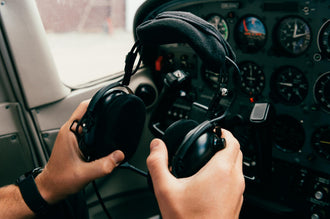
Loud & Clear – The Importance Of Aviation Radio Etiquette
- 15 Mar, 2021
For new pilots, the radio can be a source of great anxiety. The amount of jargon and technical terms used during a standard radio transmission can be intimidating to someone just getting to grips with operating a plane. Without proper instruction, these pilots may lack the ability to impart crucial information to passengers, other planes and air traffic control that could potentially avoid disaster.
Being able to concisely and effectively communicate in the cockpit is essential to staying safe in the air. New pilots don’t just need a good quality headset (though that is important!) but need to be able to use it well. The sensitive environment of an airplane calls for an awareness of what you say and how you say it, so to help new pilots keep themselves and others safe, we’ve created this short article listing a few things to be aware of next time you’re about to push the talk button.
Proper preparation
Before you even start the engine, you can take steps to ensure that you’re communicating effectively. If you have an intercom, ensure that the squelch is set properly so that it only activates when you speak at a conversational volume. Setting the squelch too low means that even low-level noise will activate it, meaning you’re broadcasting cabin noise. Setting it too high means that you’ll have to shout to activate it, leading to messages potentially getting cut off and crucial information getting lost.
Speak up
Some student pilots are anxious about the prospect of speaking on the radio, afraid that they’ll say something stupid or inaccurate. While you need to be certain that what you’re saying is correct, it’s even more important to keep air traffic controllers and other pilots up to date on situations as they develop, even if you aren’t in possession of all the facts. Letting other people know about a potentially dangerous situation even as you’re still figuring out the extent of it can be the difference between worrying for nothing and a real incident.
Keep It Simple, Student
Especially when communicating with air traffic control, it’s essential that you keep your transmissions to the bare minimum. At larger airports, traffic controllers could be tracking dozens of planes simultaneously, so make their job easier by providing a concise, accurate update on your course and intentions and get off the radio.
Brush up on your aviation etiquette and ensure that you’re heard properly with a high quality headset from Pilot Communications.




